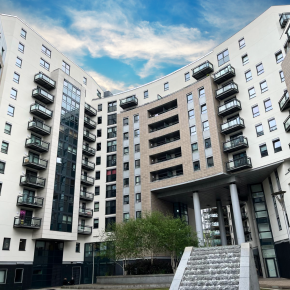
GUEST ARTICLE: Rethinking existing schools to create powerful learning spaces
 This guest article from Clara Garriga Serrano, Project Director at Holmes Miller, looks at existing schools can be rethought to create powerful learning spaces…
This guest article from Clara Garriga Serrano, Project Director at Holmes Miller, looks at existing schools can be rethought to create powerful learning spaces…
“The education landscape is rapidly transforming. Growing student populations and new adaptive teaching methods are driving the need for more flexible and engaging learning environments within communities. However, limited space, tight budgets, and net-zero ambitions make building new schools a challenging option.
Traditionally, changes in school capacity or the need to replace tired amenities meant building new facilities on separate sites, often leaving existing buildings underutilised, abandoned, or costly to demolish. Yet, many current learning spaces have untapped potential for transformation. By thinking outside of the box to make the most of what we already have, we can find sustainable and more affordable ways to accommodate the rising demand for inclusive educational environments.
Learning Places Scotland
This month, I’ll be joining experts from across the country at the Learning Places Scotland conference, shining a light on some of the biggest challenges facing Scotland’s learning estate today. The event will focus on maximising opportunities to enhance the learning experience and equip pupils for success – an endeavour I’m passionate about driving forward.
Adapting older schools to meet modern needs can bring significant social, economic and environmental benefits. For communities, preserving a building’s historical significance promotes a feeling of continuity and connection, reinforcing a sense of place that spans generations. Rather than being dismissed to make way for new structures, buildings that have stood the test of time can be revitalised to strengthen community connections and protect architectural heritage.
Sciennes Primary School
At Sciennes Primary School in Edinburgh, built in the late 1800s, we embraced the challenge of replacing outdated learning facilities to provide a new and inclusive space where pupils can thrive. This venture didn’t come without challenges; we worked closely with the City of Edinburgh Council to ensure our design complemented the surrounding conservation area, minimising intrusion for local residents.
New adaptions can never replicate the character of 100-year-old designs, nor should they. The key is to listen to the surrounding communities, ensuring our buildings respect and reflect the local character, context, and history, and contribute positively to the area’s infrastructure.
Unlike the school’s original design, which features small, closed-plan classrooms, the new annex introduces a contemporary, open-plan concept that supports evolving teaching methods and encourages collaboration. It includes four spacious classrooms interconnected by flexible teaching areas that offer a range of communal and quiet workspaces. The interior design highlights natural materials, integrated window sill benches, and acoustic treatments that double as pinboards, while glazed screens throughout each floor and strategically placed voids promote visibility and encourage pupil interaction.
Passivhaus
The design meets Passivhaus standards and is nearing certification, which has been achieved through a fabric-first approach and meticulous attention to detailing. For instance, the building comprises an exposed CLT (Cross Laminated Timber) structure which reduces cold bridging, increases airtightness and stores carbon to ensure sustainability while also creating a unique internal aesthetic.
The project also transformed a previously unused rear playground, maximising outdoor space with interactive play areas and a rain garden to enrich knowledge and build social relationships. Connecting indoor and outdoor spaces is vital for the development and wellbeing of young pupils, reinforcing a holistic approach to learning.
Sciennes Primary School exemplifies how traditional buildings can be transformed to create new, adaptable and sustainable spaces, without starting from scratch. By breathing new life into what already exists, we can provide healthy environments that benefit pupils. And with the net zero agenda at the forefront, enhancing existing structures instead of opting for new builds can substantially reduce carbon emissions, helping councils and communities achieve their sustainability goals while significantly reducing energy costs for years to come.
Reimagine what is possible
The Learning Places Scotland conference offers an opportunity to reimagine what is possible for the nation’s learning estate. By exploring creative solutions and sharing best practices, we can reshape educational spaces to be more resilient, sustainable, and engaging. The conversation extends beyond individual projects; it’s about inspiring a shift across the education system to prioritise adaptive reuse, community-driven design, and environmentally responsible practices.
The path forward lies not just in constructing new schools but in transforming the places we already have into vibrant, purposeful environments where students can thrive. Together, we can build a sustainable future for education, one project a time.”
Latest news

4th February 2025
Wetherby Wall Systems: Guiding the Industry Through Gateway 2 Compliance
As the construction sector adapts to the UK’s Building Safety Act 2022, Wetherby Wall Systems, part of the ROCKWOOL Group, is positioned to support industry professionals in navigating the new regulatory landscape.
Posted in Articles, Building Industry News, Building Products & Structures, Building Regulations & Accreditations, Building Services, Building Systems, Cladding, Facades, Facility Management & Building Services, Insulation, Posts, Restoration & Refurbishment, Retrofit & Renovation, Security and Fire Protection, Walls
3rd February 2025
Senior takes the lead on sustainability with new appointment
Senior Architectural Systems, the UK’s largest privately-owned manufacturer of aluminium windows, doors, and curtain walling, has appointed Luke Osborne to the newly created role of UK sustainability lead.
Posted in Aluminium Products, Architectural Ironmongery, Articles, Building Industry News, Building Products & Structures, Building Regulations & Accreditations, Building Systems, Doors, Recruitment, Restoration & Refurbishment, Retrofit & Renovation, Sustainability & Energy Efficiency, Windows
3rd February 2025
Gilberts: The Fine Detail of Special Needs Support
The ‘outstanding’ Highfurlong School is demonstrating its excellence via the attention to detail in its new extension – even the Gilberts ventilation has been chosen to support specific pupil needs.
Posted in Air Conditioning, Articles, Building Industry News, Building Products & Structures, Building Services, Case Studies, Facility Management & Building Services, Heating, Ventilation and Air Conditioning - HVAC, Posts, Restoration & Refurbishment, Retrofit & Renovation
3rd February 2025
C-TEC launches fire alarm mains isolator key switches range
Leading life-safety systems manufacturer C-TEC has launched an innovative range of ultra-safe fire alarm mains isolator key switches.
Posted in Articles, Building Industry News, Building Products & Structures, Building Services, Facility Management & Building Services, Health & Safety, Innovations & New Products, Retrofit & Renovation, Security and Fire Protection, Videos
 Sign up:
Sign up: